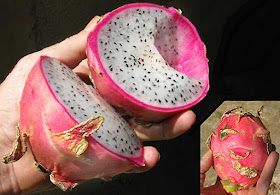Pitaya fruit comes in two main varieties, the sweet version (pitaya dulce) and the sour version (pitaya agria). Wondering how to eat these unique fruits? The rough, thick skin is not typically eaten, but cutting the fruit in half exposes the soft edible flesh. This flesh can be eaten raw, blended in smoothies, grilled, or cooked. The beautiful flowers of the pitaya fruit are also frequently steeped as tea. Feeling adventurous? Try these awesome dragon fruit recipes!
 Pitaya fruit are praised for being low-calorie and high Vitamin C, as well as for their polyunsaturated fat (omega-3 and omega-6)-rich seeds. Pitaya fruit contains no cholesterol or saturated fat, some fiber, and little sugar. They do, however, contain polyphenols, which are thought to potentially reduce the risk of some cancers!
Pitaya fruit are praised for being low-calorie and high Vitamin C, as well as for their polyunsaturated fat (omega-3 and omega-6)-rich seeds. Pitaya fruit contains no cholesterol or saturated fat, some fiber, and little sugar. They do, however, contain polyphenols, which are thought to potentially reduce the risk of some cancers!
The sweet variety is much more popular thanks to its mildly sweet taste, creamy pulp, delicate scent, and a slight tartness. Its texture and taste is comparable to kiwi or watermelon. The sour variety has a stronger taste with a sour, yet refreshing, juicier flesh. Both varieties have black seeds in the flesh, much like kiwi, that contribute a slight nutty taste, pleasing crunch, and fiber to bootcactus.
Pitaya’s bright red color and unique, leathery, leafy skin makes this fruit stand out. So it’s no wonder that it is quickly becoming popular for its mildly sweet flavor, various nutrition benefits, and flexibility in recipes.
tags:pitaya,fiber to boot,cactus species,




